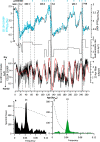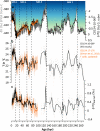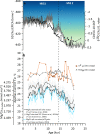A late Pleistocene dataset of Agulhas Current variability
- PMID: 33177538
- PMCID: PMC7659013
- DOI: 10.1038/s41597-020-00689-7
A late Pleistocene dataset of Agulhas Current variability
Abstract
The interocean transfer of thermocline water between the Indian and the Atlantic Oceans known as 'Agulhas leakage' is of global significance as it influences the Atlantic Meridional Overturning Circulation (AMOC) on different time scales. Variability in the Agulhas Current regime is key in shaping hydroclimate on the adjacent coastal areas of the African continent today as well as during past climates. However, the lack of long, continuous records from the proximal Agulhas Current region dating beyond the last glacial cycle prevents elucidation of its role in regional and wider global climate changes. This is the first continuous record of hydrographic variability (SST; δ18Osw) from the Agulhas Current core region spanning the past 270,000 years. The data set is analytical sound and provides a solid age model. As such, it can be used by paleoclimate scientists, archaeologists, and climate modelers to evaluate, for example, linkages between the Agulhas Current system and AMOC dynamics, as well as connections between ocean heat transport and Southern African climate change in the past and its impact on human evolution.
Conflict of interest statement
The authors declare no competing interests.
Figures






Dataset use reported in
- doi: 10.1038/ncomms2897
- doi: 10.1038/srep18153
References
-
- Lutjeharms JRE. Three decades of research on the greater Agulhas Current. Ocean Sci. Discuss. 2006;3:939–995. doi: 10.5194/osd-3-939-2006. - DOI
-
- Gordon AL. Interocean Exchange of Thermocline Water. Journal of Geophysical Research. 1986;91:5037–5046. doi: 10.1029/JC091iC04p05037. - DOI
-
- Rühs S, Schwarzkopf FU, Speich S, Biastoch A. Cold vs. warm water route – sources for the upper limb of the Atlantic Meridional Overturning Circulation revisited in a high-resolution ocean model. Ocean Sci. 2019;15:489–512. doi: 10.5194/os-15-489-2019. - DOI
-
- Rühs S, Durgadoo JV, Behrens E, Biastoch A. Advective timescales and pathways of Agulhas leakage. Geophysical Research Letters. 2013;40:3997–4000. doi: 10.1002/grl.50782. - DOI
Publication types
Grants and funding
LinkOut - more resources
Full Text Sources
Research Materials
Miscellaneous

